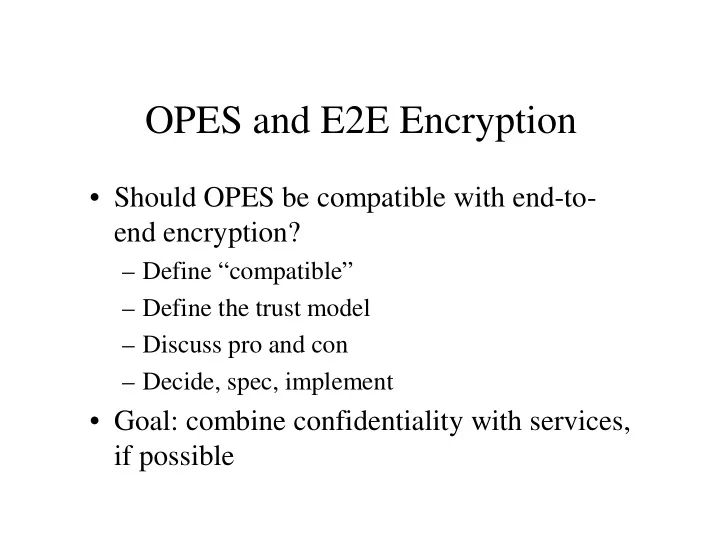

OPES and E2E Encryption • Should OPES be compatible with end-to- end encryption? – Define “compatible” – Define the trust model – Discuss pro and con – Decide, spec, implement • Goal: combine confidentiality with services, if possible
What is E2E Encryption? • Alice and Bob have a mutual interest in keeping their communication confidential • Alice and Bob open a communication channel with – Mutual authentication – Encrypted data – Reason to believe that only Alice and Bob hold the symmetric keys • Resolved, OPES will not compromise E2EE
If It’s Not E2E, What is It? • Alice to Carol to Bob to Carol to Alice • Alice and Bob trust Carol to keep their communication confidential • Alice has an encrypted channel to Carol, Bob has an encrypted channel to Carol • Hop-by-hop or link-level confidentiality • Advantage: If Alice and Bob value Carol’s help, they can utilize it by trusting only her
Would you trust your OPES intermediary to ... Who is Where did Bob this guy? find this clown? Some friend of Alice? ? • Question: is it sufficient for Alice to trust Carl? For Bob to trust Carl? • Suppose Carl trusts Earl? • Fact: The more parties, the less security
To Be Resolved • Should OPES support concatenated confidential links? • Must co-administered callout servers use encryption with an OPES intermediary? • How to signal confidentiality requirements? • How is delegation policy negotiated? • Must all links be visible to and approved by Bob and Alice?
If Linked E2EE is Allowed... • Need policy requirements • Policy representation • Policy configuration • Signaling • Prior art in hop-by-hop setup? • Or … ?
And what about the callouts? Who are Bob and Alice?? I’ve got no idea what to do here; I’m sending everything to Earl, my callout server ?
Multi-party Integrity • Integrity is easier – You can delay the checks – With digital signatures, anyone can do the verification – No necessity to share secrets • Channel integrity - SSL or Ipsec • Message integrity – Complex policies with multiple delegations – Fine-grained control
Message Manifests • Table of contents for a multi-part message • Access control per part – Right: delete, replace, append, delegate – Allowed parties: identify by name, by key, etc. • Modification actions appended to the manifest • Signature over original message + mods • Monotonic delegation (can only limit rights)
Policy Expression via Manifests • Message addressed to principal • No message content • Describes messages to be subjected to policy – URL with wildcards – Modified by name principals – Containing delegation – Etc.
Manifests with OPES • OPES intermediary can tell if message originator allows callout server action – Before sending a message or message part – After modification has occurred • Callout server can determine if another organization can modify a message – Even if the callout server cannot! • Receiver or agent can validate all changes
Recommend
More recommend